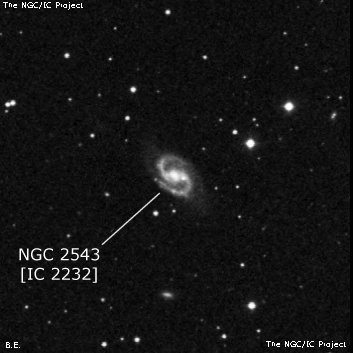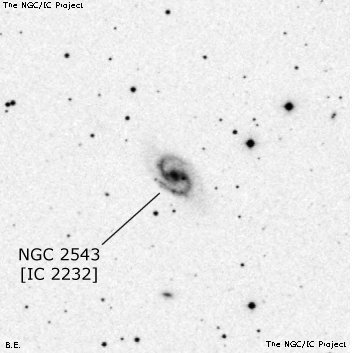NGC/IC Project Restoration Effort
(This is a very very beta version)
NGC2543


Basic Information
Location and Magnitude
Right Ascension: 8:12:57.8
Declination: +36:15:13
Constellation: LYN
Visual Magnitude: 11.9
Historic Information
Discoverer: Herschel W.
Year of discovery: 1788
Discovery aperture: 18.7
Observational
Summary description: F, pL, iR, vgbM, D * nr
Sub-type: SBb
Corwin's Notes
=====
NGC 2543 = IC 2232. The galaxy was first seen by WH in Feb 1787, and was
reobserved in Mar 1790. The two positions that he measured are not in
particularly good agreement (08 09.6 +36 20 and 08 09.8 +36 35). JH picked it
up once in Feb 1832. His position is 08 11 45, +36 24.6, also not in good
agreement with either of his father's determinations. However, Sir John notes
a "a coarse ** p points to it." This note is correct, and the "double star" is
quite wide.
The GC and NGC adopted sort of a mean of these three (08 10 43 +36 24.7)
which was corrected by Dreyer in the IC 1 notes, following Spitaler (08 09 38
+36 24.7). Actually, Spitaler's micrometric position (measured in Dec 1891)
reduces to 08 09 42.9 +36 24 07, using the GSC position for his comparison
star, and ignoring its (unknown) proper motion.
Javelle scanned the field in Feb 1896 and his position (for IC 2232) reduces
to (again ignoring proper motion) 08 09 42.5 +36 24 12, agreeing well with
Spitaler. Thus, there is no question that the two different numbers apply to
the same object.
This identity was first suggested as being the same as N2543 by Reinmuth in
1926, and every catalogue since has made the equality. The descriptions of
the galaxy and the surrounding star field simply nail the lid, leaving no
doubt about the equivalence of the two entries.
Steve's Notes
=====
NGC 2543
17.5" (3/28/92): fairly faint, moderately large, elongated 3:2 SW-NE, 2.0'x1.5', very small brighter core. Two mag 11.5 stars are 2.4' NW and 3.9' NW on a line with NGC 2543.



